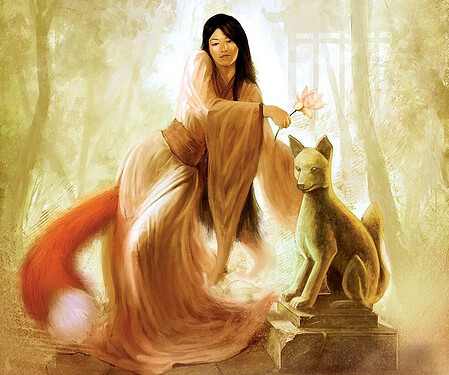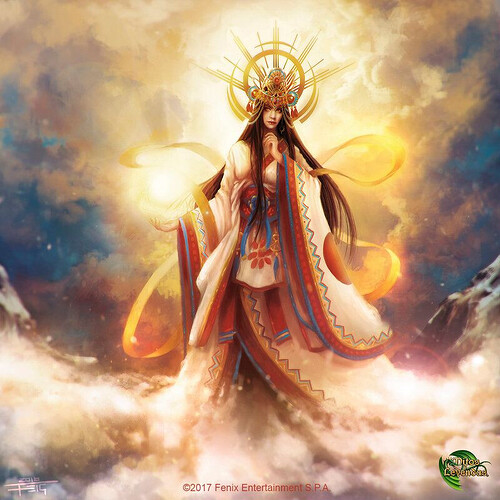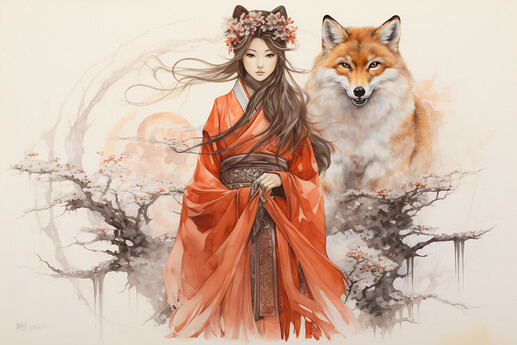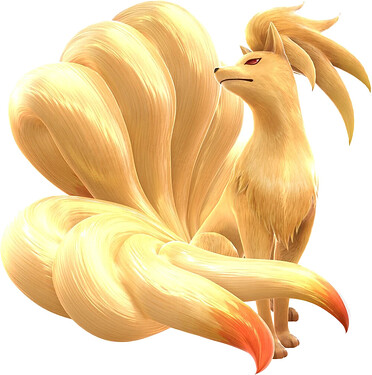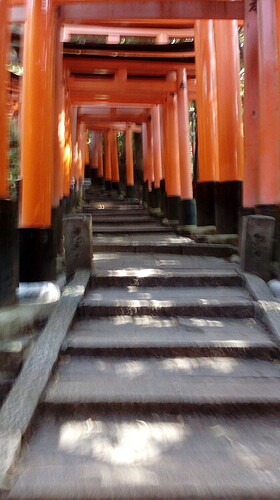For as long as humans have interacted with them, foxes have captivated hearts and souls around the world. Their wide range of colors and mischievous spirit seem to call to many people as both friend and foe! Though deities and spirits associated with foxes are not common in European and American folklore and mythology, there are three well-known deities specifically associated with foxes in Asian culture, specifically from China and Japan.
In this post, we will learn a bit about each of these fox deities – are they friend or trickster?
 Common Fox Correspondences
Common Fox Correspondences 
Below is a list of common concepts that foxes are associated with. Please keep in mind that this list is not exhaustive – if you have an association for foxes that is not on this list, that is perfectly okay!
- cunning
- intelligence
- trickery
- deception
- survival
- magic
- liminality
- independence
- strategy
- stealth
- messengers of the spirit world
- the fire element
- night and twilight
Húxiān (狐仙) (pronounced as Hoo-syæn), is a genderless deity in Chinese folklore and Daoist traditions. They are also one of the Five Great Immortals in Chinese religious belief. With a name meaning “Fox Immortal”, Húxiān is heavily associated with fox spirits. Though this deity is genderless, Húxiān is often depicted as a beautiful woman or a fox with nine tales. Húxiān is revered as a protective deity particularly popular in northern China where temples are dedicated to them as a household guardian.
Húxiān embodies themes of transformation, magic, cunning, fertility, and sometimes seduction. These associations, coupled with the genderless depiction of the deity, perfectly reflect the widespread belief that foxes can shapeshift. In Daoist and folk traditions, Húxiān is sometimes linked to immortals and deities of wealth, love, and wisdom, further solidifying their importance in Chinese religion.
Húxiān is still worshiped in modern times, particularly in parts of northern China. It is common for devotees to seek Húxiān’s blessing for prosperity, protection, and fertility. Some also believe that Húxiān can offer guidance in personal or business matters. Temples to Húxiān still exist, and some followers practice home offerings, often leaving food, incense, or small tokens to honor them.
Amaterasu Ōmikami (天照大御神) (pronounced as Ah-mah-teh-rah-soo Oh-mee-kah-mee) is the Japanese Shinto sun goddess. She is one of the most important deities in Japanese mythology, revered as the ruler of the heavens and the ancestral deity of the imperial family. According to one legend, Amaterasu and her brother, Susanoo, got into an argument and she withdrew into a cave, plunging the world into darkness.
One version of this myth depicts Amaterasu entering the cave as a dragon-fox, connecting her with the fox’s spirit and symbology. Once she was in the cave, she refused to come out. The other kami (Japanese deities or spirits) lured her out of the cave with a mirror and joyful performance. This myth also shows how Amaterasu symbolizes light, purity, life, and creation.
Amaterasu Ōmikami is still widely venerated in Shinto practice. Her most important shrine is Ise Grand Shrine (Ise Jingū) in Mie Prefecture, Japan. There, she is worshiped not only as the ruler of the heavens but also as a divine protector of Japan. People travel to her shrine to offer prayers for blessings, protection, and national prosperity. She is also honored in various Shinto festivals, particularly the Kannamesai Festival, where the emperor presents the year’s first harvest to her. Many Shinto shrines across Japan include prayers and rituals dedicated to her, showing just how important she is to Japanese culture and Shinto religious practice.
Inari Ōkami (稲荷大神) (pronounced Ee-nah-ree Oh-kah-mee) is also an influential and heavily revered deity in Shinto practice. Another gender-fluid deity, Inari is associated with rice, fertility, agriculture, prosperity, and protection. Depictions of Inari vary, though they are most commonly shown as a woman or a fox. According to one myth, Inari, as a megami (female kami), was said to have arrived in Japan when it was first created amidst a harsh famine. The story says that she descended from Heaven riding on a white fox carrying sheaves of grain for the people. This story begins Inari’s connection with the fox, but it does not end there.
Inari’s primary symbol is the fox, or kitsune, which is believed to be their messenger. This messenger represents the fox’s association with cunning, intelligence, and fertility. It is said that Inari’s kitsune are all white. Some believe that Inari themself is a fox, though that belief is discouraged by both Shinto and Buddhist priests.
Inari’s shrines are scattered across Japan, but the Fushimi Inari Taisha in Kyoto is the most famous. There, the thousands of vermilion torii gates leading to the shrine symbolize the passage between the physical and spiritual worlds. The path to the shrine, as well as the shrine itself, are adorned with fox statues to guard the shrine and guide those who travel to the shrine to worship. Modern worship of Inari includes worshippers seeking blessings for agricultural success, business prosperity, protection, and fertility. Offerings of food, especially rice and sake, are commonly made to Inari.


